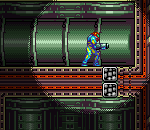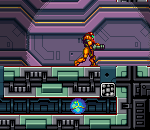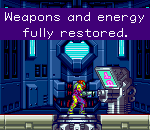Data
Guides and strategies
Media
Metroid Fusion review
![]() Metroid Fusion bore a heavy weight on its shoulders. Paired with the original release of Metroid Prime in North America in late 2002, the duo marked the end of the eight-year-long wait for a Metroid sequel since the legendary Super Metroid hit in 1994 - so you can imagine that expectations were going to be big. While Metroid Prime took the series in a new direction with its first-person vantage, Metroid Fusion retained the more traditional path of 2D platforming, and was made in Japan by the hands of Nintendo's Research & Development 1 team - the same team responsible for Super Metroid.
Metroid Fusion bore a heavy weight on its shoulders. Paired with the original release of Metroid Prime in North America in late 2002, the duo marked the end of the eight-year-long wait for a Metroid sequel since the legendary Super Metroid hit in 1994 - so you can imagine that expectations were going to be big. While Metroid Prime took the series in a new direction with its first-person vantage, Metroid Fusion retained the more traditional path of 2D platforming, and was made in Japan by the hands of Nintendo's Research & Development 1 team - the same team responsible for Super Metroid.
While it may seem that Metroid Fusion's style was taking a much less risky path to Prime's first-person shenanigans, Fusion did shake things up a bit and deliberately avoided becoming a simple Super Metroid clone. While the setting of both games began aboard a space station, Fusion's setting remained completely aboard the station from start to finish. Samus' new nemeses - the parasitic and horrific lifeform known only as X - also proved a far deadlier adversary to the eponymous Metroids and ties up the story of the classic games quite nicely.
We begin the game as Samus is sent to investigate an explosion aboard the ridiculously massive BSL (Biologic Space Labs) research station. She had just barely survived an attack by an X parasite down on the surface of good old SR388, been saved by the last infant Metroid twice over thanks to an injection of Metroid DNA, had her suit drastically change in physical appearance from bulky orange to streamline blue, and lost her ship to a rogue asteroid belt. Not a good day in any bounty hunter's books.
![]() With her trademark gunship lost, Samus is granted a fancy new purple-hued starship by the Galactic Federation, equipped with a highly intelligent AI companion. This is essentially the first time we see Samus with an accompaniment during a mission, so it does hinder the normal feeling of utter isolation a tad. The AI is essentially a guide - it directs Samus throughout the station as she completes a liner progression of objectives. At first this sounds completely alien to the feeling of open and untethered exploration present in earlier iterations of Metroid, and rightly so. The end result is more like a combination of Metroid II's gradual-but-linear progression and Super Metroid's interconnected world. To its credit, every sub-mission in Fusion is different and varied so there's always something new to look forward to when reporting in at a Navigation Room.
With her trademark gunship lost, Samus is granted a fancy new purple-hued starship by the Galactic Federation, equipped with a highly intelligent AI companion. This is essentially the first time we see Samus with an accompaniment during a mission, so it does hinder the normal feeling of utter isolation a tad. The AI is essentially a guide - it directs Samus throughout the station as she completes a liner progression of objectives. At first this sounds completely alien to the feeling of open and untethered exploration present in earlier iterations of Metroid, and rightly so. The end result is more like a combination of Metroid II's gradual-but-linear progression and Super Metroid's interconnected world. To its credit, every sub-mission in Fusion is different and varied so there's always something new to look forward to when reporting in at a Navigation Room.
Thankfully Samus' upgrades, item collection and control system has remained faithful to the 2D series. Missiles are fired by holding R and pressing B, so there's been a slight change due to the Game Boy Advance's lack of an X and Y button, but it doesn't take long to pick things up. Nice touches like Samus' ability to grab hold of the edge of ledges and cliffs to pull herself up are a welcome change.
The method of acquiring new upgrades for Samus is another first for the series. Thanks to the initial X attack, all of Samus' main abilities are lost and must be recovered by finding and defeating a variant of deadlier X known as a Core-X. The Federation routinely sends upgrade data for her as well (they never explain how sending data into her suit can actually result in physical upgrades - maybe Samus just needs the software and the hardware does the rest?).
![]() This brings us to the tenacity of the X parasites. Even though the Metroid vaccine grants Samus complete immunity to X infection, their mimicked forms are another story. These creatures operate like a hive mind - and every single one of them is out to get Samus. The enemies are fierce, especially the Core-X forms which literally fly straight towards Samus relentlessly. The inclusion of the SA-X - an X mimicking Samus in her classic Varia Suit at full power - stalking players around the station keeps the tension high, especially when initially you won't know when the creep will turn up and everything you throw at it harmlessly bounces off. It's a tough day for Samus when all she can do is run and escape from such a foe.
This brings us to the tenacity of the X parasites. Even though the Metroid vaccine grants Samus complete immunity to X infection, their mimicked forms are another story. These creatures operate like a hive mind - and every single one of them is out to get Samus. The enemies are fierce, especially the Core-X forms which literally fly straight towards Samus relentlessly. The inclusion of the SA-X - an X mimicking Samus in her classic Varia Suit at full power - stalking players around the station keeps the tension high, especially when initially you won't know when the creep will turn up and everything you throw at it harmlessly bounces off. It's a tough day for Samus when all she can do is run and escape from such a foe.
When Fusion was originally shown at E3 2001, graphically the game was surprisingly very basic - it almost looked as though the game was originally intended for the 8-bit Game Boy Color. Thankfully the final result looked right at home on the Game Boy Advance. The visuals easily surpass the 16-bit era, and it's great to see smooth animations performed so well on the GBA hardware.
You might think that setting the entire game aboard a space station would result in repetitive hallways and corridors - however, at times aboard the station you'll think Samus has found herself under the surface of a planet once more, from beautiful renditions of SR388's underground to Norfair-inspired boilers and arctic freezers. Creatures from the real SR388 and Zebes also show up, along with a few others you probably wouldn't expect to see here.
![]() Of course no atmosphere would be complete without an engaging soundtrack. Minako Hamano originally composed music for Super Metroid, and her composition work in Fusion along with Akira Fujiwara quite nicely sets the tone of the game. Bass-heavy remixes of classic themes and new interludes help convey the tension and bring each unique location of the station to life (especially when the SA-X turns up). The Metroid series' music has always been an important part of setting the atmosphere of isolation and eerie locations full of nasty critters, and Fusion's audio doesn't disappoint.
Of course no atmosphere would be complete without an engaging soundtrack. Minako Hamano originally composed music for Super Metroid, and her composition work in Fusion along with Akira Fujiwara quite nicely sets the tone of the game. Bass-heavy remixes of classic themes and new interludes help convey the tension and bring each unique location of the station to life (especially when the SA-X turns up). The Metroid series' music has always been an important part of setting the atmosphere of isolation and eerie locations full of nasty critters, and Fusion's audio doesn't disappoint.
Another tradition Metroid Fusion keeps are the rewards when completing the game under a certain amount of time. Five variations of Samus posing with or without her Fusion Suit await players depending on completion time and item collection rate. The best image requires the game to be conquered in under two hours with all items found - a definite challenge in itself. As of this writing, Fusion is also the final game in the Metroid chronology, so until Nintendo decide to continue the story beyond Samus' trip to the BSL station, the events here bring Samus' adventures to a (hopefully temporary) close in the timeline.
But the R&D1 team have done a terrific job with Metroid Fusion, successfully passing the torch from Super Metroid to the 32-bit GBA handheld and introducing a fresh new individual take for Samus' bounty hunting days. Will the Federation still have a paycheck waiting for her upon mission completion?
Written by Falcon Zero on 1 January 2010.
















